From durability to design freedom: The rise of GRC
Partner Content produced by KHL Content Studio
08 October 2025
SPONSORED CONTENT
Profit margins in the construction industry are historically thin.
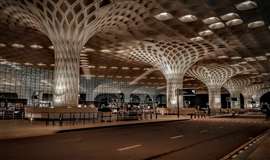 An example of GRC application with WizARG™ at the international airport in Mumbai, India. Image: Adobe Stock
An example of GRC application with WizARG™ at the international airport in Mumbai, India. Image: Adobe Stock
Avoiding unnecessary risk is always key and construction businesses have historically been somewhat reluctant to explore new methods and materials.
However, a few years ago, we saw an event which forced many to change their outlook.
During the coronavirus pandemic of 2020 and 2021, a host of paused projects, along with social distancing, furloughs and redundancies, squeezed the industry and caused thousands of experienced construction workers to leave or retire.
In the wake of the pandemic, many businesses were forced to re-evaluate their traditional practices and the adoption of, for example, digital technology and offsite construction methods increased.
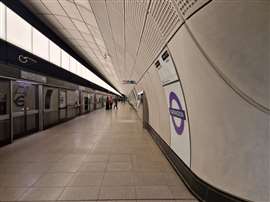 WizARG™ was used in the expansion of Farringdon Station in London, UK
WizARG™ was used in the expansion of Farringdon Station in London, UK
Construction may still be a somewhat conservative industry, but it is now more open than ever to new technologies, methods and materials.
Designed for the future
One material gaining traction in construction is GRC, or glass fibre reinforced concrete – an alternative to steel-reinforced concrete.
This is by no means a new innovation, but it’s fair to say that it is far from a mainstream construction material.
This might seem strange, given that GRC is known to be significantly more durable than traditional concrete.
Its higher initial cost and the need for upfront planning for its use have been cited as drawbacks, but it is now playing an increasingly important role in the construction of some of the world’s most significant building projects.
And GRC’s many applications are now gaining attention from construction businesses that see long-term benefits such as extended lifespan, lower maintenance costs and a range of sustainability pluses.
Jun Yamashiro is the sales manager with the glass fibre division of NEG (Nippon Electric Glass), a company with over 70 years’ experience in producing specialist glass products.
 Jun Yamashiro, Sales Manager, WizARG™ Glass Fibre Division, NEG. Image: NEG
Jun Yamashiro, Sales Manager, WizARG™ Glass Fibre Division, NEG. Image: NEG
He says GRC is particularly effective as an exterior material for buildings with high design requirements.
“Complex-shaped concrete structures tend to become significantly larger when constructed with steel-reinforced concrete,” he says, “making them difficult to realise.
“In contrast, GRC allows for a reduction in concrete thickness, making it an ideal solution for such projects.”
He adds, “GRC is significantly lighter than precast concrete, which can lead to lower transportation and installation costs.”
According to Jun, standard concrete is strong in compression, but weak in tension, which is why it can tend to break down.
As a composite material, made by embedding an alkali-resistant glass fibre network into cement, GRC offers the tensile strength that standard concrete lacks.
“The result is a material that is stronger, more durable and more flexible than traditional concrete,” says Jun. “GRC’s fibres prevent the formation of large cracks and hold the material together, making it suitable for thin-walled, complex architectural designs – especially facades, cladding and decorative elements.”
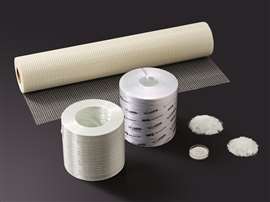 Alkali-resistant glass fibre. Image: NEG
Alkali-resistant glass fibre. Image: NEG
In the built environment, any reduction in maintenance means a reduction in costs, which can make all the difference to the success or failure of a project.
With standard reinforced concrete, one of the main causes of deterioration is the corrosion of the embedded steel reinforcement.
Jun says GRC offers an advantage, here “as its reinforcing material consists of alkali-resistant glass fibres, which are not susceptible to corrosion. This contributes to its long-term durability.”
Another benefit of GRC is in safety. “Since the glass fibres used as reinforcement are non-combustible, GRC also offers reliable fire resistance,” he says.
Reinforcing a return on investment
It’s fair to say that GRC is likely to have a higher initial cost than traditional steel-reinforced concrete, due to the higher cost of the glass fibres and necessary plasticisers, combined with a slightly more complex and energy-intensive manufacturing process.
Jun argues, however, that the overall cost may be comparable or even lower in the long run, due to reduced labour and handling costs (GRC is lighter than its steel-reinforced cousin), faster installation times and lower lifetime maintenance costs.
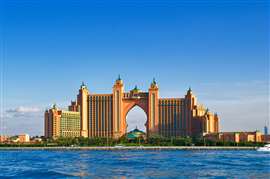 WizARG™ was used in the construction of the huge Atlantis - The Palm hotel resort in Dubai, UAE. Image: Adobe Stock
WizARG™ was used in the construction of the huge Atlantis - The Palm hotel resort in Dubai, UAE. Image: Adobe Stock
Jun’s division of NEG produces a specially formulated alkali-resistant glass fibre, WizARG™, which offers a broad line-up in terms of hardness, flexibility and thickness and is available in a number of sizing agents, filament diameters, and cut lengths.
“This,” he says, “allows us to propose the most suitable type of glass fibre based on the specific needs of each customer, which could be anything from GRC panels to crack control in concrete.”
He adds that, no matter the application, the thickness and weight of concrete structures can be reduced through the use of WizARG™, “allowing for wider spans in applications like large ceilings and reducing the amount of reinforcement needed.
“This enhances the design flexibility of structural engineering and contributes to the realisation of more aesthetically pleasing designs.”
Added to this, WizARG™ requires significantly less cement than steel-reinforced concrete; just one of a number of potential environmental benefits, which could benefit developers looking to get major projects up and running.
A very hot topic
Experiments with GRC were taking place in the 1950s, but the material only became widely available in the 1970s, following the development of alkali-resistant glass fibres, which gave it superior corrosion resistance.
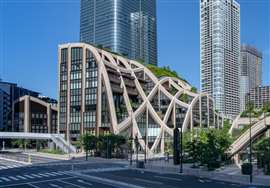 An example of GRC application with WizARG™ from the Azabudai Hills urban complex in Tokyo, Japan. Image: Adobe Stock
An example of GRC application with WizARG™ from the Azabudai Hills urban complex in Tokyo, Japan. Image: Adobe Stock
These glass fibres had a high zirconia content and this, according to Jun, is one of the crucial distinctions between GRC products.
“The ability of the glass fibre to resist corrosion from the alkaline nature of cement,” he says, “is determined mainly by the zirconia [ZrO₂] content in the glass. Basically, the higher the zirconia content, the greater the alkali resistance.”
NEG says WizARG™ contains a high ZrO₂ content among commercially available alkali-resistant glass fibres, giving it “outstanding alkali resistance”.
Another differentiator is the manufacturing process – which takes place under strict quality control standards in Japan. The key to this process is to ensure it uniformly disperses and orientates the glass fibres within the concrete.
The method of manufacturing the WizARG™ glass fibre includes processing in an all-electric direct melt furnace, which converts almost all its electrical energy into heat in an extremely uniform way, producing a more stable fibre.
The future of fibre
Up to this point, the benefits of GRC have been seen largely in building facades, cladding panels and other aesthetic architectural components, where its light weight and design versatility come to the fore.
But things are changing; more designers are seeing GRC’s benefits within roofing and walls. It is also being used as tunnel lining and formwork, and it is potentially a game changer within the world of modular construction.
Jun also says WizARG™ has “excellent potential within coastal and marine facilities, as concrete is prone to carbonation due to the influence of salt and humidity, which in turn accelerates the corrosion of rebar.
“WizARG™ remains unaffected in performance even if the concrete carbonates.”
Now, with smart technologies, such as 3D printing, driving more complex architectural designs, and a market focused on resource efficiency and reducing environmental impact, the future for high-quality GRC looks promising.
--------
This article was produced by KHL Content Studio in collaboration with experts from NEG
--------
If you have further questions or would like to learn more about GRC or WizARG™, please complete the form HERE and an NEG representative will respond to your query.
--------
All images courtesy NEG
--------




